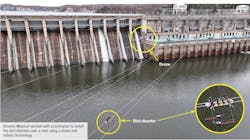Bald eagles are flocking to the Lake of the Ozarks region in Missouri. To protect the nation’s symbol, Ameren Missouri recently installed high-visibility flight diverters on distribution and high-voltage transmission lines over Bagnell Dam before the eagles began to nest in the area for the winter. Prior to the installation, Ameren Missouri conducted an environmental permitting review, which included avian protection.
For many years, the utility has partnered with the U.S. Fish and Wildlife to assess possible hazards and reduce their impact on the avian population. For example, linemen have installed covers prohibiting not only eagles, but also raptors, hawks, owls, and other large birds from striking multiple energized phases at the same time.
Through its avian protection program, Ameren is not only protecting wildlife, but also the integrity of the distribution system, according to Kurt Rakers, supervising engineer with Ameren Missouri.
"It helps our energy delivery system and maintains resiliency for our customers,” he said. “At the same time, if there is any accidental collisions or phase-to-phase contact, we would be putting our customers out of power. Ameren also strives to be a good steward of the environment and maintain a conscious effort for the birds as well.”
Randy Hunt, supervising engineer at Ameren Missouri, said the company has been intentional about taking proactive measures to protect birds throughout its region. “Our avian protection programs have resulted in reduced avian-related incidents within our service territory and have become a model for other utilities,” he said.
Installing Diverters
Line crews recently installed new transmission lines near Osage Energy Center at the Lake of the Ozarks. This was a prime opportunity to use avian protection, in particular flight diverters, on those new transmission and adjacent distribution lines.
Typically, linemen would install the bird diverters using hot sticks. Because the power lines were above a river, Ameren considered alternative approaches. Drones provided the safest and most reliable installation method compared to using a helicopter. In collaboration with Power Line Sentry, the manufacturer of the Hawk Eye Bird Flight Diverters and Fulcrum Air, flight diverters were installed with the LineFly robot for the first time on an Ameren system.
"The drone and robot are safely controlled by the Fulcrum Air pilots, which is the quickest, safest, and most effective method for bird diverter installation at this time," Rakers said.
During the installation, the team maintained communication with the pilot and an onlooker to ensure safety in the power line environment.
“Once the robot is in position, it drives down the length of the wire, precisely installing each of the Hawk Eye diverters,” Rakers said. “They are designed to be installed onto the wire by the robot in a fashion that allows the diverter to cradle the conductor without pinching, compressing or causing damage to the wire.”
As Fulcrum Air installed the bird diverters, a bald eagle sat up in a tree and watched the action unfold.
“It was really incredible,” Rakers said. “He was very curious as to what we were doing as we installed the diverters over the 35 kV lines.”
Preventing Collisions
Avian collisions are most common in low-light times like dawn and dusk due to the birds’ feeding, roosting, and nesting behaviors. The birds are most active during these time periods as they search for spots to perch to look for food.
The risk of collisions may also be increased in low-visibility weather conditions.
"Because the birds’ risk of collision increases in low light, reflective and glow-in-the-dark materials were vital,” Rakers said. “We used Hawk Eye Bird Flight Diverters that glow-in-the-dark, are reflective, and have 360-degree visibility. "These high-visibility line markers prevent high speed collisions by providing time and distance for the bird to divert from that power line.”
This contrast can be achieved through surface area, texture, brightness, reflection and glow, he adds.
“As these birds are utilizing the river, they are not paying attention to their path of travel,” Rakers said. “They have feeding on their minds at that point in time, and these catch their eye.”
As part of the project, Fulcrum Air installed a total of 300 highly reflective markers on the distribution and transmission lines.
During the installation, flight diverters were placed every 30 ft on the power lines to meet the recommendations of the Avian Power Line Interaction Committee. For locations with a history of bird collisions, the diverters are placed in 15 ft increments.
At Ameren, line crews are involved with avian protection on an everyday basis. If the crews cannot meet these spacing requirements, they are required to place polyethylene covers over the live-line parts of the conductors and devices. The hotline parts are covered to prevent phase-to-phase contact.
“The materials that Ameren uses to cover the conductors and devices are evolving on an everyday basis to gain extra life,” Rakers said. “Going forward we plan to maintain our spacing requirements and adhere to avian specifications, however, if there is room for improvement, Ameren will strive to achieve it.”
Amy Fischbach ([email protected]) is the Field Editor for T&D World magazine.
Editor’s Note: To learn more about the project, listen to Line Life podcast at www.tdworld.com/podcasts.



